On Jan. 10, 1942, Capt. Francis S. Low, an operations officer on the staff of Adm. Ernest J. King, commander in chief of the US Fleet, was at Norfolk, Va., for inspection of the Navy’s newest carrier, USS Hornet.
As his aircraft prepared to depart for Washington, Low glanced out the window at the outline of a carrier deck that had been painted on the runway to train Navy pilots in short takeoffs and landings. Just then, two Army two-engine bombers swept by, practicing a low-level bombing pass.
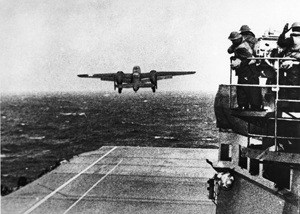 |
A Doolittle Raider takes off from the flight deck of USS Hornet, headed for Japan. |
Through Low’s mind flashed the thought that, if such bombers could take off from a carrier deck, they could bomb Japan.
The United States was still reeling from the attack on Pearl Harbor the month before, and Japan had continued to rack up one victory after another in the Pacific. President Roosevelt wanted a bombing raid on Japan as soon as possible to bolster the nation’s morale.
The Navy’s carrier-based aircraft couldn’t do it. Their operating radius was 300 miles; a carrier could not safely steam that close to Japan. Army bombers, however, had more range. If they could launch from a carrier deck, then the Navy could sail them within striking distance of the enemy home islands.
Low took his idea to King, who referred it to Lt. Gen. Henry H. “Hap” Arnold, Chief of the Army Air Forces, who agreed. The AAF War Plans Division had been studying the feasibility of launch from a carrier but nothing had yet come of it. Low’s proposal was the beginning of the project.
Arnold sent for Lt. Col. Jimmy Doolittle, who was already a famous aviator. In the 1920s, he had won air races, set aviation records, and was the first pilot to fly an airplane completely on instruments. He left the Air Corps in 1930 but returned to active duty in 1940. Arnold brought him to Washington as his troubleshooter and promoted him to lieutenant colonel.
One of Doolittle’s first tasks was to decide which AAF bomber had the potential to fly the mission against Japan. It had to take off within 500 feet, carry 2,000 pounds of bombs, and travel 2,000 miles with a full crew. It also had to roll down a carrier deck without hitting the superstructure of the ship’s island.
The wingspread of the Douglas B-23 was too wide. The Martin B-26’s takeoff roll was too long. By default, the choice was the North American B-25, a sturdy medium bomber that entered service in 1941.
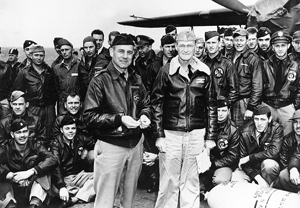 |
Lt. Col. Jimmy Doolittle (standing, left) and Capt. Marc Mitscher, USS Hornet’s commanding officer, with Army Air Forces crew members aboard the carrier. |
Practice, Practice, Practice
To be certain the concept would work, two B-25s on Feb. 3, 1942 were loaded onto Hornet at Norfolk and taken 100 miles out to sea for a flight test.
An aircraft launching from a carrier gets an extra lift boost from the speed of the ship pushing into the wind. When the pilot of the first B-25, Lt. John E. Fitzgerald, climbed into the cockpit, he saw that “the plane’s airspeed indicator showed about 45 miles per hour sitting there,” Doolittle said. “This meant he had to accelerate only about 23 miles per hour.” The B-25s were up and away without difficulty. They did not carry a combat load of fuel and munitions, but they had demonstrated basic feasibility.
Doolittle’s handwritten plan in February 1942 called for the carriers to transport the bombers to within 400 or 500 statute miles of the coast of Japan.
The B-25s would take off at night, bomb Tokyo at dawn, cross the East China Sea, land and refuel in the vicinity of Chuchow in eastern China, and fly on to Chungking. The bombers would then be turned over to new AAF units forming there.
The Chinese and American forces in China and India would be asked to prepare landing fields, pre-position fuel, and set up homing beacons. They would not be given much information in advance. Secrecy was tight: Only five people knew the full plan. There is some question about how much the President was told, but Arnold said in his memoirs that Roosevelt “was kept constantly advised on the details.”
The expectation was that no airplane would fly farther than 2,000 miles nonstop, but the B-25s were modified to go 2,400 miles if necessary. The bottom gun turrets were ripped out, along with whatever else Doolittle deemed nonessential, to make room for three extra gas tanks. Each airplane would have 1,141 gallons of fuel, the final 50 gallons carried in five-gallon cans to top off the tanks in flight.
There was no effort to handpick the crews. They were average AAF crews from the 17th Bombardment Group at Columbia, S.C. All were volunteers, told that it would be a hazardous mission, but the details were not disclosed to them.
They trained at Eglin Field, Fla., March 9-25, with as much secrecy as Doolittle could impose. They practiced short takeoff, cross-country flying, night flying, navigation, and low-altitude bombing.
The Navy assigned a carrier pilot from Pensacola, Fla., Lt. Henry L. Miller, to instruct them in carrier techniques. Doolittle, 45 years old, qualified along with the others, a self-imposed condition if he was to lead the mission. If he did not pass, he would fly as copilot instead. He passed.
By the time they left Eglin, the B-25 pilots could take off in 350 feet or less into a 46 mph wind. On March 25, they flew to California to meet Hornet, which was waiting for them at Alameda Naval Air Station in San Francisco Bay. Doolittle himself followed the rules of secrecy he had laid down for others. He told his wife only that he would “be out of the country for a while.”
Hornet steamed out of San Francisco April 2 with 16 Army B-25s clearly visible on the open deck. Fortunately, no security problems came of this. That afternoon, when the ship was well out to sea, Doolittle told the crews what most of them had already guessed, that their destination was Tokyo.
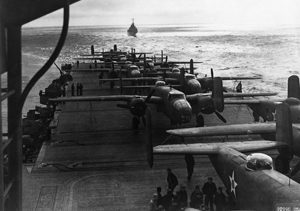 |
B-25s crowd the flight deck of Hornet en route to the launch area, which was more than 700 miles from the center of Tokyo. |
Along with them on Hornet was their Navy coach, Hank Miller, who went on to retire as a rear admiral and to be one of the very few individuals named as an honorary Tokyo Raider.
On April 13, Hornet and the raiders made rendezvous at sea with Task Force 16, led by Vice Adm. William F. Halsey Jr. from his flagship, the carrier Enterprise. Until the bombers launched, Halsey was in command.
The raid was originally set for April 19 but was moved up a day because the Navy was running ahead of schedule. It was undesirable to remain in dangerous waters any longer than necessary. Doolittle spoke to the crews April 17. “If all goes as planned, I’ll take off tomorrow afternoon so as to arrive over Tokyo by dusk,” he said. “I’ll drop incendiaries. The rest of you will take off later and can use my fires as a homing beacon.”
However, the Japanese discovered Task Force 16 long before that and Doolittle had to make wholesale changes to the plan. The raiders would bomb Tokyo in the afternoon instead of at night, and they would reach China in darkness rather than daylight.
Unknown to the Americans, the Japanese had a line of radio-equipped picket boats about 750 miles from the Japanese coast. At 3:10 a.m. April 18, Enterprise detected two surface ships and took evasive action. At 6 a.m., a Navy scout airplane spotted what appeared to be a fishing craft. At 7:44 a.m., Hornet intercepted a radio transmission from a picket boat reporting “three enemy carriers.”
The cruiser Nashville sank the picket boat, and at 8 a.m., Halsey ordered Hornet to launch the bombers.
The carrier turned into the wind and gathered speed, the bow rising and falling in rough seas. Doolittle, first to take off, positioned his aircraft on two lines painted on the deck, one for the left wheel and one for the nose wheel. If he kept his wheels on the lines, he would clear the carrier island on his right by six feet. Doolittle had 467 feet of deck in front of him. Aided by the carrier’s speed of 23 mph and a 35 mph wind blowing across his wings, Doolittle was airborne at 8:20 a.m. with deck to spare.
By the original plan, Doolittle would have gone three hours ahead of the others to mark the targets with firebombs, but Lt. Travis Hoover, in aircraft No. 2, took off five minutes after Doolittle and soon joined up with him. The 16th and last airplane was airborne at 9:19 a.m.
Official records and historical accounts vary on how far the raiders had to fly to reach their targets, but they launched more than 700 miles from the center of Tokyo and almost 10 hours sooner than planned. Doolittle had expected the carrier to take the raiders several hundred miles closer to Japan.
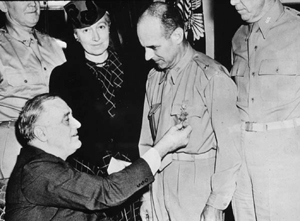 |
President Franklin Roosevelt pins the Medal of Honor on Doolittle’s uniform at a White House ceremony. |
From All Directions
The strike force consisted of 16 aircraft and 80 airmen. Each B-25 carried a crew of five: pilot, copilot, navigator, bombardier, and engineer-gunner. Nine of the bombardiers were enlisted, including SSgt. Fred A. Braemer on Doolittle’s crew. To conserve fuel, the raiders flew toward Japan at slow speeds and at low level.
Meanwhile, the Japanese dispatched aircraft to intercept the carriers. Halsey reversed course and the task force headed east at top speed.
The presumption was that authorities in China would learn of the raid by radio and be ready to receive the raiders earlier than planned. As a backup, Doolittle asked Halsey to send notification once the B-25s were launched.
For reasons never fully explained, Halsey did not send the message: News of the early attack never reached Chuchow.
The Japanese had received the warning from the picket boat but they were not yet alarmed. They knew that US Navy aircraft had to get within 300 miles of Japan to launch a strike and the enemy carrier was not nearly that close.
There had been an air raid drill that morning, and at midday, numerous Japanese military airplanes were in flight over Tokyo, practicing for an upcoming celebration of the emperor’s birthday.
It was not immediately clear that Tokyo was under enemy attack. The raid was not a strike by massed airpower as had been the case at Pearl Harbor.
The raider aircraft were spread out over an area 50 miles wide and 150 miles deep and they approached Tokyo from various directions. They carried differing mixes of 500-pound demolition bombs and incendiary bombs, depending on their assigned targets.
Doolittle was first to reach the target. He swept over Tokyo at rooftop level, pulled up to release four incendiary bombs on a factory complex, then dropped to low level again. His first bomb dropped at 12:25 p.m.
Heading out over the western outskirts of Tokyo, Doolittle saw a dozen airplanes lined up at an aircraft plant, but he had no bombs left.
The first 10 raider aircraft struck Tokyo, and the other six hit Yokohama, Nagoya, Kobe, and Osaka. Most of them bombed their primary targets, which included factories, warehouses, mills, industrial plants, and the Tokyo waterfront.
Fires spread quickly because of the flimsy nature of Japanese construction. Big columns of smoke arose from the northeastern part of Tokyo. By the time aircraft No. 10 dropped its bombs, the air defenses were fully aroused, but the Tokyo part of the raid was over.
In absolute military terms, the raid did not do much harm to Imperial Japan, but there was a great psychological effect.
The Japanese claimed to have shot down nine of the raiders. They said the bombers had concentrated on schools and hospitals but did not do much damage except to nonmilitary targets. In actuality, the Japanese knew that they had been taken by surprise and feared that the Americans might strike again, and in greater strength. The Japanese were unnerved enough to retain four Army fighter groups in the home islands even though they were urgently needed in the South Pacific.
In public, Adm. Isoroku Yamamoto, commander in chief of the Imperial Fleet and architect of the Pearl Harbor attack, disparaged Doolittle’s “Do-Nothing Raid.” However, Yamamoto was more convinced than ever that Japan had to extend its defensive perimeter eastward. The raid helped convince Japanese leaders to attempt to seize Midway, where the Japanese fleet was defeated in June 1942 in a critical carrier battle generally regarded as a turning point in the Pacific war.
All 16 aircraft exited Japanese airspace satisfactorily, but the consequences of the premature launch began to catch up with them. Because of the additional distance to fly, the B-25s would have run out of fuel 200 miles short of the coast of China had it not been for a tailwind that pushed them along for seven hours and gave them about 250 extra miles of range. Even so, 15 of the aircraft crashed in China or were ditched near the shore.
Doolittle and several of the others managed to reach Chuchow, about 200 miles south of Shanghai and 70 miles inland. The base was in a narrow valley and landing in the dark was not possible without lights or a homing beacon. Instead, Doolittle said, “When our planes were heard overhead, an air raid warning alarm was sounded and lights were turned off.”
Doolittle tried to contact the field but got no answer. Around 9:15 p.m., Doolittle and his crew bailed out north of Chuchow and came down in a rice paddy. They had been in the air for 2,250 miles.
Over the next several weeks, most of the raiders made their way to Chungking and friendly territory. They would not have been able to do so without the help of Chinese all along the way. Most of eastern China was under the control of the Japanese army.
The Japanese sent 53 battalions on a three-month search and reprisal campaign through Chekiang (now Zhejiang) Province, where most of the raiders had landed. They wiped out entire villages, men, women, and children, killing fully a quarter of a million Chinese.
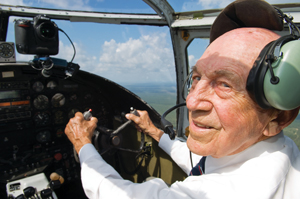 |
Retired Lt. Col. Richard Cole, the copilot on Doolittle’s aircraft, pilots a B-25 over Eglin AFB, Fla., during a 2008 re-enactment of the raid. (USAF photo by Lance Cheung) |
Japanese Claims
Lt. Ted W. Lawson ditched aircraft No. 7 in the East China Sea, a quarter of a mile offshore. His leg was badly injured in the crash and was amputated in China by Lt. Thomas R. White, a physician who volunteered for the mission and flew as a gunner on crew No. 15. Lawson recounted the mission in Thirty Seconds Over Tokyo, published in 1943 and later made into a movie with Spencer Tracy as Doolittle and Van Johnson as Ted Lawson.
The gunner on aircraft No. 3, Cpl. Leland D. Faktor was killed on bailout over China. Two crew members from No. 6 were badly injured and drowned when their aircraft ditched.
The Japanese captured the survivors from aircraft No. 6 and No. 16 and executed the two pilots, Lt. Dean E. Hallmark and Lt. William G. Farrow, and one of the engineer-gunners, Sgt. Harold A. Spatz. Another crew member died in captivity. The remaining four POWs came home at the end of the war.
The only aircraft that did not reach China was No. 8, piloted by Capt. Edward J. York, which had an engine problem and was burning fuel at a ruinous rate. Getting to China was not possible so York landed at a Soviet field near Vladivostok. The Soviets seized the airplane and interned the crew. After 14 months, the airmen finally managed to escape from the USSR by making their way into Iran (or, as it was called then, Persia).
Back in the United States, officials were anxious in the days immediately following the raid. They had heard nothing from Doolittle, and the New York Times was quoting the Japanese claim that nine airplanes had been shot down.
In the eternal way of bureaucrats, US officials floated the story to reporters that “such an attack could have been made without direct orders from Washington” and that execution of such a mission “would be the concern chiefly of the Army and Navy officials entrusted with the task of carrying it out.”
It was soon learned that the news from Japan was untrue. Reaction of the American public to the raid was overwhelmingly positive.
Roosevelt enjoyed weeks of goodwill as a result of it, and identified himself closely with the mission. At a press conference April 21, Roosevelt vouchsafed that the bombers had come from “our new secret base at Shangri-La.” (Shangri-La was an isolated and mystical valley in Tibet in James Hilton’s popular novel, Lost Horizon, which had been made into a likewise popular movie.)
On April 28, while he was still in China, Doolittle learned that he had been promoted to brigadier general, skipping the grade of colonel. Years before, he had also skipped the grade of captain, leaving the Air Corps in 1930 as a lieutenant and joining the Air Force Reserve as a major.
Doolittle was awarded the Medal of Honor despite his protests that he did not deserve it. It was presented at the White House May 19 with Gen. George C. Marshall, Chief of Staff of the Army, reading the citation and Roosevelt pinning the medal on Doolittle’s shirt.
All of the other raiders received the Distinguished Flying Cross. In addition, Lieutenant White, who amputated Lawson’s leg, and Cpl. David J. Thatcher, engineer-gunner on Lawson’s crew, were awarded the Silver Star for their aid to the wounded.
Official Washington decided that information about the mission should be managed to preserve the boost to the nation’s morale and to keep the Japanese guessing.
Doolittle, at the instigation of the War Department, told reporters that none of the airplanes were shot down and “none was damaged to an extent that precluded its proceeding to its destination.” That was true so far as it went but left out some basic points.
National Anger and Pride
It was almost a year before the War Department released “additional details” on April 20, 1943, revealing that one airplane had come down in Soviet territory and that the others had been lost in China. There was some grumbling from the New York Times and others about misleading information the year before, but that was instantly forgotten when Roosevelt announced that three of the raiders had been executed by the Japanese. That set off a wave of national anger and fresh pride in what the raiders had accomplished.
Jimmy Doolittle went on to command Twelfth Air Force in North Africa and Fifteenth Air Force in the Mediterranean Theater. In 1944, promoted to lieutenant general, he took command of Eighth Air Force in England and directed the finish of the strategic bombing offensive against Germany. Doolittle was the highest-ranking reserve officer to serve in World War II.
In 1946, he returned to civilian life. Among other achievements, he became the first leader of the newly founded Air Force Association, serving as President in the period 1946-47 and as Chairman of the Board 1947-49. He retired from the Air Force Reserve as a lieutenant general in 1959, but was advanced to four-star rank on the retired list by Congress in 1985. Doolittle died in 1993.
The carrier Hornet took part in the Battle of Midway and the Solomons campaign and earned four battle stars before being sunk by Japanese dive bombers and torpedo airplanes in the Battle of Santa Cruz in the South Pacific in October 1942.
The Navy in 1944 named an aircraft carrier Shangri-La. Roosevelt called the new Presidential retreat in the Maryland mountains Shangri-La, but the name was later changed by President Eisenhower to Camp David.
Cpl. Jacob D. DeShazer, bombardier on aircraft No. 16 and prisoner of the Japanese for three years, returned home, went to college, and became a Methodist missionary in Japan for 30 years. In 1950, he gained his most remarkable convert: Mitsuo Fuchida, the former Japanese Navy officer who led the air attacking force against Pearl Harbor in 1941.
In 1958, North American Aviation rebuilt a B-25D to the configuration of the B-25B flown by Doolittle on the raid. The aircraft was donated to the raiders and is currently exhibited at the National Museum of the US Air Force in Dayton, Ohio.
In 2008, seven of the surviving raiders went to Eglin, to take part in a re-enactment of their training there for the raid. Three B-25s provided the aerial part of the re-enactment.
Each year, around April 18, the surviving raiders gather for a reunion. During the event, there is a moment of solemn ritual. Visitors leave the room, silver goblets are brought out, and a toast is drunk “to those who have gone.” If a raider has died in the past year, his goblet is turned upside down by a member of his crew. Most of the 80 goblets—stored at the Air Force Museum between reunions—are upside down. When only two raiders remain, they will drink the toast from a bottle of brandy that has accompanied the goblets, unopened, to every reunion since 1960. At the beginning of 2009, nine raiders survive, including Lt. Col. Richard E. Cole, who was Doolittle’s copilot on aircraft No. 1. The 2009 reunion will be held in Columbia, S.C., April 17-18.